Risso's dolphin
Risso's dolphin (Grampus griseus) is a dolphin, the only species of the genus Grampus. Some of the closest related species to these dolphins include: pilot whales (Globicephala spp.), pygmy killer whales (Feresa attenuata), melon-headed whales (Peponocephala electra), and false killer whales (Pseudorca crassidens).[5]
| Risso's dolphin[1] | |
|---|---|
 | |
 | |
| Size compared to an average human | |
| Scientific classification | |
| Domain: | Eukaryota |
| Kingdom: | Animalia |
| Phylum: | Chordata |
| Class: | Mammalia |
| Order: | Artiodactyla |
| Infraorder: | Cetacea |
| Family: | Delphinidae |
| Genus: | Grampus Gray, 1828 [4] |
| Species: | G. griseus |
| Binomial name | |
| Grampus griseus (G. Cuvier, 1812) | |
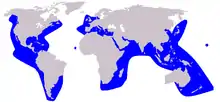 | |
| Distribution of Risso's dolphin | |
Taxonomy
Risso's dolphin is named after Antoine Risso, whose study of the animal formed the basis of the recognized description by Georges Cuvier in 1812.[6] The holotype referred to specimen at the Muséum National d'Histoire Naturelle, an exhibit using preserved skin and skull obtained at Brest, France.[7]
The type and sole species of the genus Grampus refers to Delphinus griseus Cuvier 1812. A proposition to name this genus Grampidelphis in 1933, when the taxonomic status of 'blackfish' was uncertain, and conserving the extensive use of "Grampus" for the 'killer' Orcinus orca", also suggested renaming this species (Grampidelphis exilis Iredale, T. & Troughton, E. le G. 1933).[8] These were recognised as synonyms after publication of the Catalog of Whales (Hershkovitz, 1966).[7]
Another common name for the Risso's dolphin is grampus (also the species' genus), although this common name was more often used for the orca. The etymology of the word "grampus" is unclear. It may be an agglomeration of the Latin grandis piscis or French grand poisson, both meaning big fish. The specific epithet griseus refers to the mottled (almost scarred) grey colour of its body.
Description
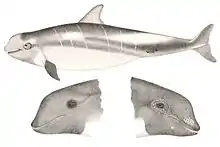
Risso's dolphin has a relatively large anterior body and dorsal fin, while the posterior tapers to a relatively narrow tail. The bulbous shape of the head has a vertical crease in front.[9]
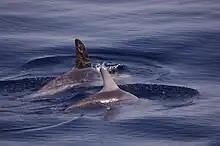
Infants are dorsally grey to brown and ventrally cream-colored, with a white anchor-shaped area between the pectorals and around the mouth. In older calves, the nonwhite areas darken to nearly black, and then lighten (except for the always dark dorsal fin). Linear scars mostly from social interaction eventually cover the bulk of the body; scarring is a common feature of male to male competition in toothed whales, but Risso's dolphin tend to be unusually heavily scarred. The pronounced appearance of these scars results from the lack of repigmentation, which may be advantageous as a display that reduces further challenges from other males.[10] Older individuals appear mostly white. Most individuals have two to seven pairs of teeth, all in the lower jaw.[9]
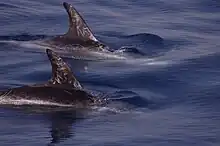
Length is typically 10 feet (3.0 m), although specimens may reach 13 feet (4.0 m).[11] Like most dolphins, males are typically slightly larger than females. This species weighs 300–500 kilograms (660–1,100 lb), making it the largest species called "dolphin".[12][13]
Range and habitat
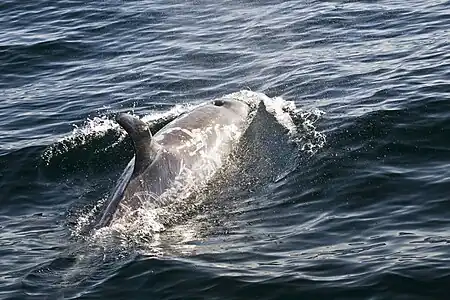
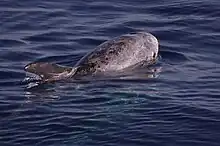
Risso's dolphins are found worldwide in temperate and tropical waters, in the Indian, Pacific and Atlantic Oceans, also the Persian Gulf, Mediterranean and Red Seas, but not the Black Sea (a stranding was recorded in the Sea of Marmara in 2012[14]). They range as far north as the Gulf of Alaska and southern Greenland and as far south as Tierra del Fuego.[9]
Their preferred environment is just off the continental shelf on steep banks, with water depths varying from 400–1,000 m (1,300–3,300 ft) and water temperatures at least 10 °C (50 °F) and preferably 15–20 °C (59–68 °F).[9] They are recorded diving to depths of 600 m (2,000 ft) in pursuit of prey.[15]
The population around the continental shelf of the US is estimated to be in excess of 60,000. In the Pacific, a census recorded 175,000 individuals in eastern tropical waters and 85,000 in the west. No global estimate exists.
Since 2017, Risso's dolphins have began to appear off the Norwegian coast, at Bleik's Canyon, Andenes. The repeated regular sightings imply an expansion of their natural range. Possible explanations are changing climate and currents as well as northwards expansion of prey species or competition with other species in their natural range, such as pilot whales.
Ecology

They feed almost exclusively on neritic and oceanic squid, mostly nocturnally. Predation does not appear significant. Mass strandings are infrequent.[9] Analysis carried out on the stomach contents of stranded specimens in Scotland showed that the most important species preyed on in Scottish waters is the curled octopus (Eledone cirrhosa).[16]
A population is found off Santa Catalina Island where they are sympatric with short-finned pilot whales (Globicephala macrorhynchus) and both species feed on the squid population. Although these species have not been seen to interact with each other, they take advantage of the commercial squid fishing that takes place at night. They have been seen by fishermen to feed around their boats.[17] They also travel with other cetaceans. They surf the bow waves of gray whales, as well as ocean swells.[9]
Risso's dolphins have a stratified social organisation.[18] These dolphins typically travel in groups of between 10 and 51, but can sometimes form "super-pods" reaching up to a few thousand individuals. Smaller, stable subgroups exist within larger groups. These groups tend to be similar in age or sex.[19] Risso's experience fidelity towards their groups. Long-term bonds are seen to correlate with adult males. Younger individuals experience less fidelity and can leave and join groups. Mothers show a high fidelity towards a group of mother and calves,[18] but it is unclear whether or not these females stay together after their calves leave or remain in their natal pods.
Behavior
Feeding
Like many dolphin species, they use echolocation to target cephalapods and fish that are feeding below. Tagging of a population in the Azores revealed that Grampus griseus plan whether to make a shallow or deep dive, with different strategies that create profitable foraging for the considerable expenditure in time and energy. Risso's can achieve depths over 600 m (2,000 ft) by exhausting their lungs and using several spins to rapidly descend, almost vertically, and increase the time spent foraging. This allows the species to exploit a deep and dispersed layer of prey such as squid, those taking refuge during daylight when they become more vulnerable to predation.[15]
Social behavior
Risso's dolphins do not require cutting teeth to process their cephalopod prey, which has allowed the species to evolve teeth as display weapons in mating conflicts.[10]
Reproduction
Gestation requires an estimated 13–14 months, at intervals of 2.4 years. Calving reaches seasonal peaks in the winter in the eastern Pacific and in the summer and fall in the western Pacific. Females mature sexually at ages 8–10, and males at age 10–12. The oldest specimen reached 39.6 years.[9]
Risso's dolphins have successfully been taken into captivity in Japan and the United States, although not with the regularity of bottlenose dolphins or orcas. Hybrid Risso's-bottlenose dolphins have been bred in captivity.
Human interactions
Like other dolphins and marine animals, there have been documentations of these dolphins getting caught in seine-nets and gillnets across the globe.[5] Many of these incidents have resulted in death.[19] Small whaling operations have also been cause of some of these deaths. Pollution has also affected many individuals who have ingested plastic. Samples from these animals shows contamination within their tissue.[5]
In Ireland, though not apparently in England, Risso's Dolphin was one of the royal fish which by virtue of the royal prerogative were the exclusive property of the English Crown.[20]
A famed individual named Pelorus Jack was widely reported between 1888 and 1912, travelling with ships navigating the Cook Strait in New Zealand. A law protecting the animal was passed after a public outcry, renewed twice more, but suggested be invalid by its reference to Fisheries acts that did not concern marine mammals.[21]
Conservation
The Risso's dolphin populations of the North, Baltic, and Mediterranean Seas are listed on Appendix II[22] of the Convention on the Conservation of Migratory Species of Wild Animals (CMS), since they have an unfavourable conservation status or would benefit significantly from international co-operation organised by tailored agreements.[23]
In addition, Risso's dolphin is covered by the Agreement on the Conservation of Small Cetaceans of the Baltic, North East Atlantic, Irish and North Seas (ASCOBANS),[24] the Agreement on the Conservation of Cetaceans in the Black Sea, Mediterranean Sea and Contiguous Atlantic Area (ACCOBAMS),[25] the Memorandum of Understanding for the Conservation of Cetaceans and Their Habitats in the Pacific Islands Region (Pacific Cetaceans MoU)[26] and the Memorandum of Understanding Concerning the Conservation of the Manatee and Small Cetaceans of Western Africa and Macaronesia (Western African Aquatic Mammals MoU).[27]
Risso's dolphins are protected in the United States under the Marine Mammal Protection Act of 1992. Currently, Japan, Indonesia, the Solomon Islands, and The Lesser Antilles hunt Risso's dolphins.[19]
Strandings
At least one case report of strandings in Japan's Goto Islands has been associated with parasitic neuropathy of the eighth cranial nerve by a trematode in the genus Nasitrema.[28] There was a recent reporting of a juvenile male Risso's dolphin that was stranded alive on the coast of Gran Canaria on 26 April 2019. This was the first documented case of capture myopathy and stress cardiomyopathy in a male juvenile Risso's dolphin that has received rehabilitation.[29]
References
- Mead, J. G.; Brownell, R. L. Jr. (2005). "Order Cetacea". In Wilson, D. E.; Reeder, D. M. (eds.). Mammal Species of the World: A Taxonomic and Geographic Reference (3rd ed.). Johns Hopkins University Press. pp. 723–743. ISBN 978-0-8018-8221-0. OCLC 62265494.
- Kiszka, J.; Braulik, G. (2018). "Grampus griseus". IUCN Red List of Threatened Species. 2018: e.T9461A50356660. doi:10.2305/IUCN.UK.2018-2.RLTS.T9461A50356660.en. Retrieved 19 November 2021.
- "Appendices | CITES". cites.org. Retrieved 14 January 2022.
- William Perrin (2014). Perrin WF (ed.). "Grampus Gray, 1828". World Cetacea Database. World Register of Marine Species. Retrieved 16 March 2015.
- Baird, Robin (2008). Encyclopedia of Marine Mammale 2nd edition. Academic Press. pp. 975–976. ISBN 9780123735539.
- Cuvier, L.C.F.D. (1812). "Rapport sur divers cétacés pris sur les côtes de France". Annales du Muséum National d'Histoire Naturelle. Paris. 19: 1–16 [13].
Delphinus griseus Cuvier, 1812.
- Hershkovitz, P. (1966). "Catalog of living whales". Bulletin of the United States National Museum (246): viii 1–259. doi:10.5479/si.03629236.246.
- Iredale, Tom; Troughton, Ellis Le G. (1933). "The correct generic names for the Grampus or Killer Whale, and the so called Grampus or Risso's Dolphin". Records of the Australian Museum. 19 (1): 28–36. doi:10.3853/j.0067-1975.19.1933.689.
- Baird, Robin W. (2009). Perrin, William F.; Wursig, Bernd; Thewissen, J. G. M. (eds.). Encyclopedia of Marine Mammals (2nd ed.). Burlington Ma.: Academic Press. p. 975. ISBN 978-0-12-373553-9. Archived from the original on 9 November 2009.
- MacLeod, Colin D. (January 1998). "Intraspecific scarring in odontocete cetaceans: an indicator of male 'quality' in aggressive social interactions?". Journal of Zoology. 244 (1): 71–77. doi:10.1111/j.1469-7998.1998.tb00008.x. ISSN 0952-8369.
- "Grampus griseus – Risso's dolphin". Animal Diversity Web.
- American Cetacean Society Fact Sheet – Risso's Dolphin Archived 11 July 2007 at the Wayback Machine
- Risso's Dolphin. Whale Web. Retrieved 22 September 2015.
- First stranding record of a Risso’s Dolphin (Grampus griseus) in the Marmara Sea, Turkey (pdf). Retrieved 6 September 2017
- Visser Fleur, Keller Onno A., Oudejans Machiel G., Nowacek Douglas P., Kok Annebelle C. M., Huisman Jef and Sterck Elisabeth H. M. 2021 Risso's dolphins perform spin dives to target deep-dwelling prey R. Soc. open sci.8:202320
- MacLeod, C.D.; Santos, M.B.; Pierce, G.J. (2014). Can habitat modelling for the octopus Eledone cirrhosa help identify key areas for Risso's dolphin in Scottish waters? (PDF) (Report). Scottish Natural Heritage Commissioned Report. Vol. 530. Scottish Natural Heritage. Archived from the original (PDF) on 24 December 2016. Retrieved 24 December 2016.
- Shane, Susan H. (1995). "Behavior patterns of pilot whales and Risso's dolphins off Santa Catalina Island, California" (PDF). Aquatic Mammals. 21 (3): 195–197 – via Aquatic Mammals Issue Archives.
- Hartman, K. L.; Visser, F.; Hendriks, A. J.E. (14 March 2008). "Social structure of Risso's dolphins (Grampus griseus) at the Azores: a stratified community based on highly associated social units". Canadian Journal of Zoology. 86 (4): 294–306. doi:10.1139/Z07-138. ISSN 0008-4301.
- "Risso's dolphin, Open Waters, Marine mammals, Grampus griseus at the Monterey Bay Aquarium". montereybayaquarium.org. Retrieved 27 April 2018.
- Ball, F. Elrington (1917). History of Dublin. Vol. 5. Dublin: Alexander Thom and Co. p. 49.
- Hutching, Gerard (1 September 2015). "The story of Pelorus Jack". Te Ara – the Encyclopedia of New Zealand. Archived from the original on 14 June 2020. Retrieved 14 June 2020.
... Pelorus Jack ....was so named because he would meet boats near the entrance to Pelorus Sound, in the Marlborough Sounds. ...'
- "Appendix II Archived 11 June 2011 at the Wayback Machine" of the Convention on the Conservation of Migratory Species of Wild Animals (CMS). As amended by the Conference of the Parties in 1985, 1988, 1991, 1994, 1997, 1999, 2002, 2005 and 2008. Effective: 5 March 2009.
- Convention on Migratory Species page on the Risso's dolphin. Cms.int (25 June 1998). Retrieved 22 September 2015.
- Agreement on the Conservation of Small Cetaceans of the Baltic, North East Atlantic, Irish and North Seas. Ascobans.org. Retrieved 22 September 2015.
- Agreement on the Conservation of Cetaceans in the Black Sea, Mediterranean Sea and Contiguous Atlantic Area. Accobams.org. Retrieved 22 September 2015.
- Memorandum of Understanding for the Conservation of Cetaceans and Their Habitats in the Pacific Islands Region. Pacificcetaceans.org. Retrieved 22 September 2015.
- Memorandum of Understanding Concerning the Conservation of the Manatee and Small Cetaceans of Western Africa and Macaronesia. Cms.int. Retrieved 22 September 2015.
- Morimitsu, T; Kawano, H; Torihara, K; Kato, E; Koono, M (1992). "Histopathology of eighth cranial nerve of mass stranded dolphins at Goto Islands, Japan". Journal of Wildlife Diseases. 28 (4): 656–8. doi:10.7589/0090-3558-28.4.656. PMID 1474668.
- Câmara, Nakita; Sierra, Eva; Fernández, Antonio; Arbelo, Manuel; Bernaldo de Quirós, Yara; Arregui, Marina; Consoli, Francesco; Herráez, Pedro (29 January 2020). "Capture Myopathy and Stress Cardiomyopathy in a Live-Stranded Risso's Dolphin (Grampus griseus) in Rehabilitation". Animals. 10 (2): 220. doi:10.3390/ani10020220. ISSN 2076-2615. PMC 7070958. PMID 32013196.
Further reading
External links
- Whale and Dolphin Conservation Society
- ARKive Photographs, video
- Voices in the Sea – Sound of the Risso's Dolphin Archived 9 July 2014 at the Wayback Machine
- Photos of Risso's dolphin on Sealife Collection
